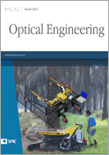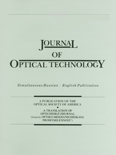
OPTICAL ENGINEERING
metrics 2024
Transforming visions into optical realities.
Introduction
OPTICAL ENGINEERING, published by SPIE-SOC PHOTO-OPTICAL INSTRUMENTATION ENGINEERS, is a premier journal in the field of optical and photonic engineering, dedicated to advancing the science and technology of optics, photonics, and imaging systems. With ISSN 0091-3286 and E-ISSN 1560-2303, this esteemed publication has been contributing to the academic community since its inception in 1972, covering a wide array of topics within its converged years of operation. As a recognized entity, the journal is presently positioned in the Q3 quartile for Atomic and Molecular Physics and Optics, and in the Q2 quartile for Engineering (miscellaneous) as of 2023. The journal’s Scopus ranks reflect its impact and significance, being placed at #129 out of 307 in General Engineering and #137 out of 224 in Atomic and Molecular Physics. Although it does not operate under an open access model, the journal remains a vital resource for researchers, professionals, and students seeking the latest advancements in optical engineering. With a focus on publishing innovative research and technical advancements, OPTICAL ENGINEERING continues to be essential for driving progress in this crucial scientific field.
Metrics 2024
 0.33
0.33 1.10
1.10 1.10
1.10 120
120Metrics History
Rank 2024
Scopus
IF (Web Of Science)
JCI (Web Of Science)
Quartile History
Similar Journals

Optica Pura y Aplicada
Transforming Ideas into Optical AdvancementsOptica Pura y Aplicada, published by the SOC ESPANOLA OPTICA, stands as a vital platform for the dissemination of cutting-edge research in the fields of Atomic and Molecular Physics, Optics, and related engineering disciplines. Established in Spain, this journal aims to foster the advancement of knowledge in optical science and technology by providing a rigorous peer-reviewed publication outlet for scholars, researchers, and practitioners. Despite being categorized in the Q4 quartile across multiple domains, including Engineering and Materials Science, the journal remains committed to contributing meaningful insights and advancements within its scope. With an ISSN of 0030-3917 and an E-ISSN of 2171-8814, the journal effectively reaches a global audience eager to explore innovative applications and theoretical developments in optics and materials science. Researchers and professionals alike will find in Optica Pura y Aplicada a valuable resource for enriching their understanding and practices in an ever-evolving field, fostering collaborations and promoting research growth until its converged conclusion in 2024.

Acta Photonica Sinica
Empowering Research in Light and MatterActa Photonica Sinica is a peer-reviewed academic journal published by SCIENCE PRESS, focusing on the fields of atomic and molecular physics and optics. Since its inception in 1997, this journal has provided a crucial platform for researchers and professionals to share cutting-edge findings and advancements in photonics and related areas. Despite its current positioning in the Q4 quartile for both atomic and molecular physics and optics, Acta Photonica Sinica remains a significant contributor to the scholarly community, fostering innovative discussions and collaborations. The journal does not currently offer open access, providing a selective but impactful repository of knowledge for readers in China and beyond. As the scientific landscape evolves, the journal aims to enhance its scope and impact, addressing the challenges and opportunities within the photonics domain. Researchers, students, and professionals interested in the latest theoretical and experimental studies will find a wealth of information that emphasizes the pivotal role of optics in scientific and technological advancements.

eLight
Fostering Innovation Through Cutting-Edge ResearcheLight is a leading academic journal published by SPRINGER NATURE, dedicated to the dynamic field of Atomic and Molecular Physics, as well as Electronic, Optical, and Magnetic Materials. Launched in 2021, the journal has quickly established itself as a reputable source of cutting-edge research, evidenced by its impressive Q1 quartile rankings in both categories for 2023, alongside remarkable Scopus rankings that place it in the top 2% of its fields. With a commitment to advancing knowledge and fostering innovation, eLight invites contributions from researchers, professionals, and students who are passionate about exploring new frontiers in these critical areas of study. Hitting a critical intersection of physics and materials science, the journal provides an open forum for the dissemination of experimental findings, theoretical studies, and application-based research, ensuring accessibility to vital discoveries that drive progress in technology and academia. Located in Singapore, eLight is poised to make significant contributions to the scientific community until at least 2024, and beyond.

ACTA OPTICA SINICA
Unveiling the Science of Light and MaterialsACTA OPTICA SINICA is a distinguished journal dedicated to the field of optics and photonics, published by the Chinese Laser Press. With an ISSN of 0253-2239, this journal has been an essential resource since its inception, covering significant discoveries and advancements in atomic and molecular physics, electronic materials, and optical sciences. The journal is indexed in Scopus, achieving respectable ranks as Q3 in both Atomic and Molecular Physics, and Optics and Electronic, Optical and Magnetic Materials, reflecting its engagement with current research trends. Although it is not an open-access journal, ACTA OPTICA SINICA is hosted from Shanghai, China, and continues to serve as a vital platform for researchers, professionals, and students alike to disseminate and access high-quality peer-reviewed articles, ensuring its prominent place in the academic discourse related to optics and material sciences.

Journal of Optics-India
Illuminating Innovations in Atomic and Molecular PhysicsThe Journal of Optics-India, published by SPRINGER INDIA, serves as a vital platform dedicated to advancing research in the field of optics, focusing on topics in both atomic and molecular physics. With an ISSN of 0972-8821 and an E-ISSN of 0974-6900, the journal has been a consistent contributor to the field since its inception in 1996 and continues to thrive with its anticipated convergence through 2024. Although currently classified in Q3 of the 2023 category quartiles, the journal actively seeks to elevate its standing within Scopus rankings in physics and astronomy, where it holds a rank of 143/224, indicating significant opportunities for growth and research impact. The Journal of Optics-India is committed to fostering innovative research and providing scholars and practitioners with access to cutting-edge findings, thereby enhancing global conversations around optics and its vast applications. As a reliable source for researchers, professionals, and students alike, the journal emphasizes quality contributions that shape the future of optical science.

Advanced Photonics
Pioneering Discoveries in Photonics and BeyondAdvanced Photonics, published by SPIE-SOC PHOTO-OPTICAL INSTRUMENTATION ENGINEERS, is a prestigious open-access journal dedicated to cutting-edge research in the fields of photonics, optics, biomedical engineering, and material science. Since its inception in 2019, this journal has successfully established itself in the top quartile (Q1) of various categories, including Atomic and Molecular Physics, Biomedical Engineering, and Electronic, Optical and Magnetic Materials, showcasing its critical role in advancing knowledge and innovation within these disciplines. With impressive Scopus rankings—#8 in Biomedical Engineering, #7 in Atomic and Molecular Physics, and #10 in Materials Science—Advanced Photonics serves as an essential platform for researchers, professionals, and students alike, offering a wealth of accessible scholarly content to keep pace with rapid technological developments. The journal not only fosters collaboration and knowledge dissemination within the global scientific community but also emphasizes the importance of open access to ensure that groundbreaking research benefits society as a whole.

Biomedical Optics Express
Shaping Tomorrow’s Solutions in Medicine and BiologyBiomedical Optics Express, published by the prestigious Optica Publishing Group, is an open-access journal that has been at the forefront of the field of biomedical optics since its inception in 2011. With an ISSN of 2156-7085, this journal has established itself as a premier platform for disseminating high-quality research that spans an array of topics in atomic and molecular physics, optics, and biotechnology. As a testament to its scholarly impact, it is currently ranked in the Q1 category for both Atomic and Molecular Physics and Biotechnology, reflecting its commitment to excellence within these disciplines. The journal features cutting-edge articles that foster innovation and collaboration among researchers, professionals, and students who are passionate about applying optical technologies to solve pressing challenges in medicine and biology. Based in the United States, Biomedical Optics Express continues to shape the future of optical science and its applications, inviting contributions that inspire and drive forward the boundaries of knowledge.

OPTICS COMMUNICATIONS
Shaping Tomorrow's Technologies with LightOptics Communications, published by Elsevier, is a prestigious international journal that focuses on the dynamically evolving fields of optics and photonics. With its ISSN 0030-4018 and E-ISSN 1873-0310, this journal has made significant contributions to the fields of Atomic and Molecular Physics, Electrical and Electronic Engineering, Electronic, Optical and Magnetic Materials, and Physical and Theoretical Chemistry, consistently ranking in the Q2 quartile across these categories for 2023. The journal, based in the Netherlands, is recognized for its rigorous peer-review process and aims to publish high-quality research articles that advance knowledge and applications in optical communication technologies. Although it operates under a subscription model, the insightful research published here plays an essential role in informing the work of researchers, professionals, and students alike. With a history dating back to 1969 and spanning well into 2025, Optics Communications remains a crucial resource for cutting-edge developments in optics, catering to a global audience dedicated to innovation in this pivotal science.

JOURNAL OF OPTICAL TECHNOLOGY
Pioneering Insights in Optical ScienceJOURNAL OF OPTICAL TECHNOLOGY, published by the Optica Publishing Group, serves as a vital resource for researchers and professionals in the fields of optical technology and related disciplines. Established with a commitment to advancing knowledge, this journal spans a broad spectrum of topics, including applied mathematics, atomic and molecular physics, and various engineering disciplines, with a converged publication period from 1995 to 2024. Although it currently holds a Q4 ranking across multiple categories in 2023, it is an important platform for innovative research ideas in a rapidly evolving field. The absence of Open Access may guide readers to explore alternative access options through institutional subscriptions. The journal’s ISSN is 1070-9762 and its E-ISSN is 1091-0786, ensuring accessibility for a global audience. As a publication aimed at fostering scholarly communication, it invites contributions that highlight emerging trends and novel developments in optical technology, catering to a multifaceted audience of researchers, professionals, and students.

OSA Continuum
Bridging Theory and Application in Optical SciencesOSA Continuum, published by the Optica Publishing Group, is a distinguished open access journal dedicated to advancing research in the realms of Atomic and Molecular Physics, Optics, and Electronic and Electrical Engineering. Since its inception in 2018, this journal has rapidly positioned itself as a significant platform for disseminating cutting-edge findings, achieving impressive Scopus rankings with a 61st percentile in Electrical and Electronic Engineering and 57th in Atomic and Molecular Physics. Based in the United States, the journal not only promotes scholarly dialogue among researchers and professionals but also plays a crucial role in bridging theoretical advances with practical applications in optical and material sciences. Its open access format ensures broader visibility and accessibility of research outputs, fostering innovation and collaboration across disciplines. With its ongoing commitment to excellence, OSA Continuum is crucial for anyone involved in these dynamic fields.